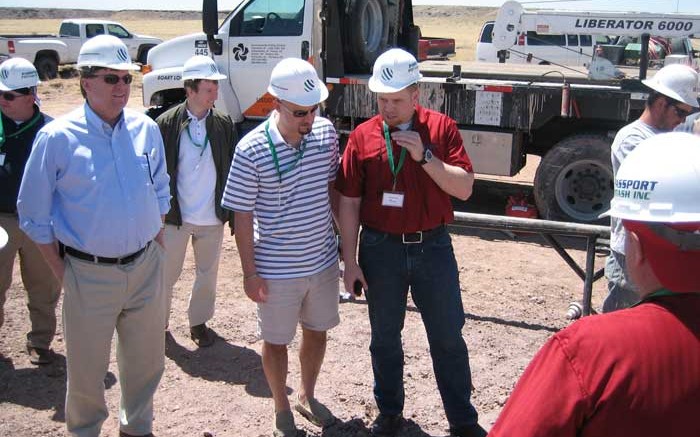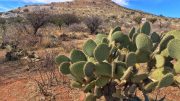Is it possible to build a potash mine right beside Arizona’s treasured Petrified Forest National Park? Vancouver-based Passport Potash (PPI-V) believes so, and has in hand a new preliminary economic assessment that’s giving it the confidence to move the project forward.
Passport’s project is in the 20,700 sq. km (8,000 sq. mile) Holbrook basin in northeastern Arizona’s Coconino, Navajo and Apache counties, about a half day’s drive up from Phoenix. Passport’s current holdings in the basin total 307 sq. km (191 sq. miles), including 175 sq. km of private land.
While the project area is tinged with desolation, the infrastructure is in fact excellent, with immediate east–west rail and road access to California and Mexico: the BNSF rail line passes through the northern stretches of Passport’s property, and Interstate 40 and Highway 180 both cut through the property. Twenty-five miles west of the project, the Arizona Public Service operates the 995 MW Cholla power plant, and Passport has already found enough brackish groundwater to operate a mine. A skilled workforce could come from the area, which recently suffered 500 job losses from the closure of the Catalyst Paper mill.
Prepared by Germany’s Ercosplan Ingenieurgesellschaft, the PEA is based on a resource of 28.8 million measured tonnes grading 14.43% potassium chloride and 285.3 million indicated tonnes at 14.81% potassium chloride. Another 638 million tonnes at 12.85% potassium chloride sit in the inferred category. Even better, the outlined deposit is only 243 to 450 metres deep.
The headline numbers in the PEA are compelling: at a production capacity of 2.5 million tonnes per year and a mine life of 26 years, the after-tax internal rate of return is 27.1% and the net present value (NPV) is US$2.2 billion, at a 12% discount rate and a potash price of US$430 per tonne. At an 8% discount rate, the after-tax NPV rises to US$4.3 billion.
The total capital expenditure is estimated at US$1.95 billion.
The Northern Miner, which visited the property in 2011, sat down with Passport president and CEO Joshua Bleak and new chairman David Salisbury over coffee in downtown Toronto to sift through the PEA news.
Based out of Passport’s operations office in the Phoenix satellite city of Apache Junction, Bleak describes himself as a fourth-generation miner from an Arizona mining family, and in addition to getting Passport going in 2008, has been associated with a number of U.S.-focused natural resource juniors.
Salisbury comes to Passport after a four-decade career notable for 17 years working with Rio Tinto, including serving as president and CEO of Resolution Copper Mining and president and CEO of Kennecott Minerals. Before that, he was president of Cordero Mining, among other executive roles in Wyoming, North Carolina and Namibia.
“From the standpoint of infrastructure, the project is great,” Salisbury says. “But one of the most important aspects of that is the fact that it’s a thousand feet below surface. It is the shallowest (potash-bearing) basin in North America, and what that gives us is the ability to develop a large production facility at lower capital costs than anyone can come in with.”
When you start looking at Canadian potash, Salisbury says, “you’re three, four thousand feet down, and you’ve got high costs to get there. Most of those are going to solution mines, because if you went a conventional way down there, it would cost a lot more than that.”
He notes that one of the things that everyone tells him is: “‘It’s not Saskatchewan thickness and grade.’ And the answer is: ‘You’re absolutely right, it’s not.’ But when you put in the economics of this project, it becomes comparable because the operating costs are not dissimilar, but you have a lower capital cost. So when you start looking at it on an NPV basis, it’s a great project.”
“This is a real opportunity that someone can take to development,” Bleak says. “As a junior company, our number-one objective is to de-risk this project to the point where it becomes bankable and permitted. Our comments have always been about thickness and grade, and the consolidated land package.”
There are three main holders of property in the basin, which is so far undeveloped, except for helium that was produced in the basin’s northeastern limit from 1961 to 1976.
A scan through a map of the claims in the basin shows Passport with a dominant position, private off-reserve land owned by the local Hopi Tribe for which Passport has negotiated a development agreement, and lastly, Hunt Oil. Passport has a fifty-fifty joint-venture and data-sharing agreement with Hunt on the latter’s claims in the southern portion of the basin.
Regarding the Hopi, Salisbury says that “they want to be a participant in this, they want to be a part of it, and once they buy land, the native tribes don’t sell them, so they’re going to be the owners evermore. But they’re willing to work out some way for us as the mining company to come in and help them generate some revenue that will go to their tribe. Plus, it creates an opportunity for jobs, and that’s a high priority for them.”
The elephant in the room is the Petrified Forest National Park, which sits smack in the middle of the basin and covers the thickest areas of potash mineralization, which could be the richest part. However, any discussion of mining in the park is completely off the table for Passport, even in informal or off-the-record conversations over the years.
“The petrified wood occurs in pockets throughout the area, and is only found down to fifty feet or so, so it’s not the same geological event that brought the potash mineralization,” Bleak says. “The park’s been in existence for a long time, and has had several expansions in its history, but not in relation to any mining event.”
In communication with the park ranger, Passport learned that the park doesn’t want any underground mine installation to mar the view within the park, so Passport has agreed to locate any plant site 11 km away.
“Our operations won’t impede any view from the park,” Salisbury says. “It will be an underground mine, so there won’t be any subsidence. There won’t be any impact at all on the park.”
Because the state lands beyond the federal park land are checkerboard in nature, Bleak says that “you need to be able to work with the intervening landowners and the private landholders. And that’s something we’ve been able to accomplish to create two major mining areas: the southern block and two sections in the northern block, immediately west of the park.”
He says the nice thing about the northern block on Passport’s private lands is that they’re “surface rights, mineral rights and water rights — and they’re all intact, and they’re royalty free.”
Passport’s southern block will have a small royalty to the state of Arizona, and the company is working with the Hopi Tribe to have them included in the operations. They’ll end up with a royalty as well.
“For the most part we are finished with the property deals,” Bleak beams. “At this point we have a 26-year mine life based on what we’ve put together now. We have so much inferred resource already, even though it’s only looking at 37% of our land, we’ll have plenty of opportunity to expand it well beyond 30 years.”
Bleak adds that “the only way you really want to add more land and have further consolidation is if a major came in and wanted to take this to a 3- to 4- to 5-million-tonne-per-year mine. That would really be the only reason to go beyond the land package tha
t we have currently.”
Passport started with 1,509 historic drill holes, and since 2011 has drilled more than 60 core holes and completed 160 km of 2-D seismic. The company added 30 Hunt holes that the oil company collared around the Passport land package.
“Our data is second to none,” Bleak says. “We have so much new data and so much quality historic data, and so the level of certainty that has gone into the PEA and then going into our prefeasibility, that is very high-level data.”
He says this high quality of data is important, because Holbrook is a non-producing basin. “In Saskatchewan, you’re got the thickness and the grade, but they’ve also got production from the last 40 years or so, so that’s a big vote of confidence, even if you are on the periphery of where the majors are producing.”
Bleak says a prime focus of this year will be to advance the required environmental permitting, and to continue with infill drilling.
The two big goals are to complete a prefeasibility study by year-end and a definitive feasibility study by the end of 2014, so that mine construction can get underway.
Money, thankfully, is not a problem for Passport right now, with the company having $5 million in cash and no debt at the end of February.
Corporately, Passport is feeling out potential partnerships with large Asian companies who could commit to much larger financings tied to off-take agreements that would see potash easily sent by rail west to ports in southern California for shipment to Asia.
At the end of February, Passport had 182.8 million shares outstanding, and traded at 17.5¢ at press time, for a market capitalization of $31 million. Shares have been bouncing around 20¢ mark for the past year, and peaked above 75¢ in early 2011.
RELATED SITE VISIT VIDEO:





Be the first to comment on "Passport sees potash aplenty in Arizona"